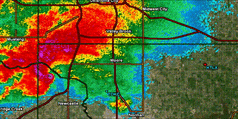2030 Moore tornado: Difference between revisions
No edit summary |
No edit summary |
||
| Line 55: | Line 55: | ||
[[Tornado outbreak of May 11-12, 2030]] | [[Tornado outbreak of May 11-12, 2030]] | ||
[[2030 | [[2030 El Reno tornado]] | ||
[[Wikipedia:2013 Moore tornado]] | [[2013 Moore tornado|Wikipedia:2013 Moore tornado]] | ||
[[Wikipedia:1999 Bridge Creek–Moore tornado]] | [[2013 Moore tornado|Wikipedia:1999 Bridge Creek–Moore tornado]] | ||
[[Wikipedia:2023 Rolling Fork tornado]] | [[2013 Moore tornado|Wikipedia:2023 Rolling Fork tornado]] | ||
== Part of == | == Part of == | ||
Revision as of 20:12, 29 ⧼april⧽ 2025
Bottom: Radar loop of the tornado as it went through Moore. | |
| Meteorological history | |
|---|---|
| Formed | May 11, 2030, 1:21 p.m. CDT (UTC-5:00) |
| Dissipated | May 11, 2030, 2:13 p.m. CDT (UTC-5:00) |
| Duration | 46 minutes |
| EF5 tornado | |
| on the Enhanced Fujita scale | |
| Path length | 15.1 miles (24.3 km) |
| Highest winds | 205 mph (330 km/h) |
| Overall effects | |
| Fatalities | 35+ |
| Injuries | 315+ |
| Damage | ~$2.1 billion (2030 USD) |
| Areas affected | Cleveland and Oklahoma Counties in Oklahoma, mainly the city of Moore |
|
| |
| Part of the Tornado outbreak of May 11-12, 2030 and the Tornadoes of 2030 | |
The 2030 Moore tornado was a catastrophic and violent EF5 tornado that struck the city of Moore, Oklahoma on May 11, 2030. As part of a larger tornado outbreak affecting the Southern Plains, this tornado caused widespread devastation across Cleveland and Oklahoma counties, leaving a trail of destruction reminiscent of the deadly tornadoes that struck the region in 1999 and 2013. The tornado reached a peak intensity of EF5 on the Enhanced Fujita scale, with estimated winds of 205 mph (330 km/h), and carved a destructive path through densely populated areas, making it one of the most intense tornadoes to impact the United States in recent history.
This was the third EF5 tornado to strike the city of Moore, following the devastating events of May 3, 1999, and May 20, 2013. It also marked the third EF5 tornado to occur in the United States since 2013, breaking a nearly two-decade lull in top-rated tornadoes. Despite the widespread damage throughout the city, the National Weather Service assigned the EF5 rating based on a single damage indicator: the complete destruction of a well-constructed restaurant in southern Moore. The rest of the tornado’s damage, while extreme, did not meet the threshold on its own for EF5 intensity.
Meteorological synopsis
On May 11, 2030, a potent combination of thermodynamic instability and strong wind shear set the stage for a significant tornado outbreak across the Southern Plains. In central Oklahoma, a surface low along a sharpening dryline intersected with a northward-lifting warm front, producing a volatile triple point environment. Surface temperatures reached 86 °F with dewpoints in the lower 70s °F, and CAPE values surged past 4400 J/kg. Steep lapse rates of 8.7 C/km in the 0-3 km layer and 7.4 C/km in the 3-6 km layer, along with SRH values nearing 460 m^2/s^2, indicated an atmosphere primed for tornadic supercells.
The Storm Prediction Center issued a Moderate Risk across Oklahoma, with a focused tornado threat zone near Moore and Oklahoma City. A Particularly Dangerous Situation (PDS) tornado watch was issued mid-afternoon. The environment supported intense, cyclic supercell thunderstorms capable of producing long-track tornadoes. As the afternoon progressed, multiple discrete supercells developed, with one tracking through Moore and producing the EF5 tornado that would go on to cause catastrophic damage and fatalities.
Tornado
The 2030 Moore tornado touched down at approximately 1:21 p.m. CDT on May 11 near Newcastle, Oklahoma, rapidly intensifying as it moved northeast into the urban core of Moore. It followed a devastatingly similar path to previous tornadoes from 1999 and 2013, tracking for 15.1 miles and reaching maximum estimated winds of 205 mph (330 km/h). The tornado was on the ground for 46 minutes and maintained EF5 intensity across much of its path through central Moore.
Radar signatures showed a classic hook echo and a strong debris ball as the storm passed over the Orr Family Farm. The tornado widened to several hundred yards as it entered densely populated neighborhoods, destroying homes, schools, and medical facilities. Vehicles were thrown long distances, and entire subdivisions were leveled. The tornado dissipated around 2:13 p.m. CDT east of Lake Stanley Draper.
Despite the immense structural devastation across Moore, the National Weather Service based its EF5 rating on a single, highly specific damage indicator: the obliteration of a well-built, anchor-bolted restaurant structure in southern Moore. The destruction of this facility, which had been engineered to withstand high winds, supported wind estimates at or above the 200 mph threshold for EF5 classification.
Impact
Damage in Moore was extreme, with thousands of structures damaged or destroyed. Entire neighborhoods were reduced to bare foundations, and some homes were swept completely clean, indicative of upper-end EF5 damage. The Orr Family Farm and nearby areas sustained catastrophic losses. Two schools were either flattened or suffered major structural damage. Power lines, gas infrastructure, and roads were severely affected, complicating rescue and recovery efforts.
At least 35 people were confirmed killed, and over 315 others were injured. Emergency personnel from across the state converged on Moore for rescue operations, and multiple hospitals reported being at full capacity. The tornado caused an estimated $2.1 billion in damage, making it one of the costliest tornadoes in U.S. history. Thousands were left homeless, and debris removal efforts stretched into the following weeks.
Much of the worst damage occurred in well-developed residential zones, where even homes built to post-2013 enhanced standards were destroyed. Cars and trucks were thrown hundreds of yards and mangled beyond recognition. Numerous trees were debarked, and many survivors described the sound of the storm as louder than a freight train. The rapid arrival and intense violence of the tornado gave residents little time to react, despite timely warnings.
Aftermath
In the aftermath of the tornado, local, state, and federal authorities declared a state of emergency. The Oklahoma National Guard and FEMA were deployed to assist with recovery. Temporary shelters were opened in unaffected parts of the city, and schools in surrounding communities were closed to facilitate housing and aid operations. Major utility disruptions persisted for days as crews worked to restore power and services.
The event prompted renewed discussions about the construction of storm shelters and safe rooms in residential homes and public buildings. Although Moore had adopted improved building codes after the 2013 tornado, the EF5 winds exceeded even enhanced structural designs in some areas. The tragedy reignited calls for nationwide reforms in tornado-resilient building practices, especially in high-risk regions.
Volunteers from across the country came to assist in clean-up and aid efforts. Relief funds were established by state and national charities, while local organizations provided food, supplies, and emotional support. The city of Moore began long-term rebuilding plans shortly after, committing to stronger safety measures and reinforcing public infrastructure to better withstand future storms.
See also
Tornado outbreak of May 11-12, 2030
Wikipedia:1999 Bridge Creek–Moore tornado
Wikipedia:2023 Rolling Fork tornado
Part of
The 2030 Moore tornado was the most destructive tornado in a two-day outbreak that produced 19 confirmed tornadoes across Oklahoma, Kansas, and Missouri. Alongside the Moore tornado, the outbreak included the 2030 El Reno EF4 tornado and several EF2–EF3 events. The moderate-risk forecast verified with multiple cyclic supercells and high-end thermodynamic profiles contributing to violent tornado development across the Southern Plains.

